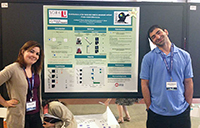How does the brain know which way is upright? How does the brain learn about the direction of gravity?

York U researchers in the Centre for Vision Research studying questions of how gravity perception works have found new evidence to suggest that this basic sensory process may be more complex than previously thought.
Though we constantly experience the force of gravity, we are seldom conscious of it, say doctoral candidate Lindsey Fraser and undergraduate honours student Bobbak Makooie, who are researching the subject under the supervision of Professor Laurence Harris.
However, say the researchers, the direction of gravity is critical to many aspects of perception and action – from keeping upright while standing, to throwing a ball and riding a bike or knowing the orientation of your own body.
Perception of gravity is often attributed exclusively to the vestibular system – a set of organs in the inner ear. This system has evolved to tell us about self-motion and head tilt relative to gravity. Mounting evidence has suggested that the orientation of the rest of the body may be an important cue for gravity perception as well.
Fraser and Makooie recently published a set of five experiments in PLoS ONE (open source article) that capitalized on principles of sensory integration to show that gravity perception is linked not only to the sensed position of the head, but to the position of the trunk as well.
“What information your brain prioritizes depends on the question you ask,” says Fraser, the first author of this study. “Participants asked to judge gravity vertical with their hands rely more on cues from the body, while a visual task relies more on head position information.”
Normally, she says, information from both the head and body are used to get an overall sense of upright.
In the final experiment of the study, the researchers found a way to separate the two “gravity senses” by applying vibration to the muscles of the neck. They found that when the head’s position relative to the body is no longer certain, humans can no longer compare the two cues coming from body and head, and are forced to pick one or the other.
This research may help us understand how astronauts and people with balance disorders could learn to overcome vestibular challenges, by learning to rely more on gravity cues coming from the rest of the body.
The novel vibration method the researchers developed provides a potential tool for teaching people how to use all cues to gravity effectively.


